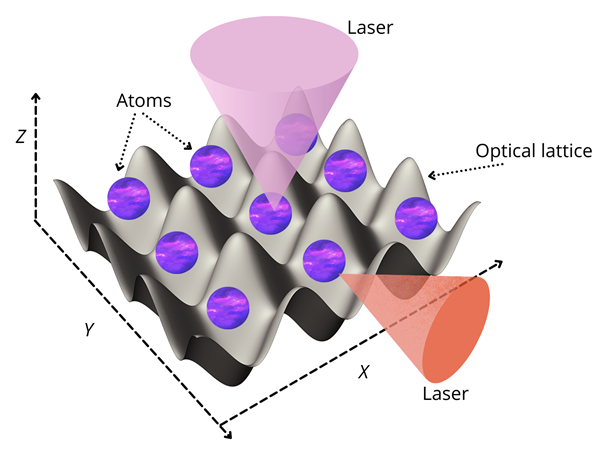Synthetic dimensions exploit the internal and motional states of quantum systems simultaneously to simulate matter in higher dimensions.

Image Credit: BAIVECTOR/Shutterstock.com
Synthetic dimensions can be used in combination with real dimensions in 3D space. Matter, studied with synthetic dimensions, behaves as if it lives in extra spatial dimensions. For example, 3D systems that are equivalent to 4D or higher. Adding 1 or 2 synthetic dimensions to the 3D allows for more control of quantum systems that is not always available in real 3D space.
Synthetic dimensions lead to quantum behavior that is not realized elsewhere in nature. Quantum strings, membranes, and topological phases are some examples that can be studied with synthetic dimensions. Experimentally, ultra-cold atomic systems offer an ideal platform to study synthetic dimensions.
Atomic, Molecular, and Optical Physics
Atomic, molecular, and optical physics (AMO) is the study of the dynamics of atomic and molecular structure with light. Early experiments were developed to perform spectroscopy of atoms to determine their energy level structure. Quantized spectrums of electronic transitions of atoms were observed through experiments.
These pioneering experiments were instrumental in developing the fundamentals of quantum mechanics and quantum field theory. With the ability to measure quantum systems, scientists were able to also control the variables that induced changes in the atomic structure. For example, using laser light to excite electrons to desired energy levels as well as creating superpositions of quantum states.
As AMO physics progressed into the 1990s, experimental control of not only the internal states of atoms, but also the motional states of matter was achieved. Atomic ensembles were cooled using a variety of techniques to near absolute zero temperatures.
Laser cooling and evaporative cooling are some examples of cooling methods employed. Bose-Einstein condensates (BECs) were experimentally observed for the first time in 1995. The realization of BECs garnered the Nobel prize in physics in 2001. In BECs, atoms were cooled to Nano-kelvin temperatures separated by distances in the order of microns. In such systems, atoms can be manipulated using lasers and electromagnetic fields with full control of tunable parameters.
Advancements in experimental techniques lead to the development of optical lattices. Optical lattices use laser beams to trap atoms in one, two, or three-dimensional arrays. Two or more intersecting laser beams can combine to form an array of peaks and valleys of light intensity as shown in figure 1. Atoms and molecules can be trapped in individual potential wells to create an array of many particles. Ideally, one atom is trapped in each lattice site.

Figure 1: Illustration of an optical lattice in 3D containing single atoms at each lattice site interrogated by lasers. Image Credit: Ilamaran Sivarajah
Imaging atoms at a single particle level is a powerful capability. Many body systems can be investigated by making projective measurements of where every particle sits. This technique was further developed as quantum gas microscopes. Quantum gas microscopes provide a lot more information than a scanning tunneling microscope (STM).
STM gives an average density at every atom. Quantum gas microscopes enable a projective measurement able to correlate multiple particle properties in a projected measurement.
Synthetic Dimensions with Atomic Systems
A synthetic dimension is an extra dimension encoded into the motional states of a particle in a real 3D space lattice potential. The extra dimension is simulated with an internal state of an atom or molecule. The internal atomic state is interpreted as distinct lattice sites along an extra dimension in the optical lattice. These states are manipulated by different suitable lasers to simulate the synthetic dimension.
For example, Rydberg states of atoms can be exploited to represent the synthetic dimension. A Rydberg atom is an atom excited into a higher energy level where the valence electron occupies an energy level far from the nucleus. Rydberg atoms interact with each other at longer distances than ground state atoms. This makes them an attractive system to study synthetic dimensions in optical lattices.
Internal states of molecules can also be used for synthetic dimensions. Molecules have rotational states that are ideal internal states to be applied as synthetic dimensions.
Synthetic dimensions offer a valuable medium to explore new physics. The important difference between real and synthetic dimensions is the difference in inter-particle interactions. In real space, spatially-close particles interact stronger than those that are far apart. In synthetic dimensions, particles that are far apart interact as strongly as those that are close together. This is because particles that are far apart in synthetic space are still nearby in real space, which enables strong interaction.
Demonstrations of Atomic Synthetic Dimensions
Atomic synthetic dimensions have been observed in various physical phenomena. A prominent study of synthetic dimensions is in topological quantum matter. Topological quantum materials are a class of matter that exhibit unusual properties like exotic surface states and anomalous transport phenomena. Topological quantum matter is unaffected by deformations like stretching, compressing, or twisting.
Apart from topological physics, synthetic dimensions have been demonstrated in artificial gauge fields, spin-orbit coupling, and in chiral edge states of two-dimensional quantum Hall systems to build optical isolators.
References and Further Reading
Kanungo, S.K., Whalen, J.D., Lu, Y. et al. Realizing topological edge states with Rydberg-atom synthetic dimensions. Nat Commun 13, 972 (2022). https://doi.org/10.1038/s41467-022-28550-y
Ozawa, T., Price, H.M. Topological quantum matter in synthetic dimensions. Nat Rev Phys1, 349–357 (2019). https://doi.org/10.1038/s42254-019-0045-3
O. Boada, A. Celi, J. I. Latorre, and M. Lewenstein. Quantum Simulation of an Extra Dimension. Phys. Rev. Lett. 108, 133001 – Published 29 March 2012. https://link.aps.org/doi/10.1103/PhysRevLett.108.133001
Disclaimer: The views expressed here are those of the author expressed in their private capacity and do not necessarily represent the views of AZoM.com Limited T/A AZoNetwork the owner and operator of this website. This disclaimer forms part of the Terms and conditions of use of this website.